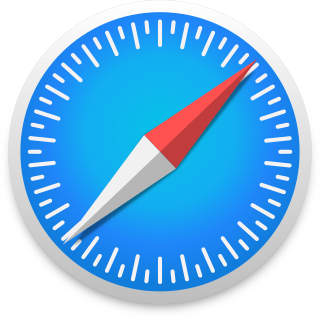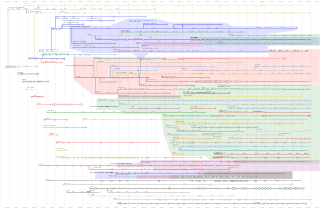
Internet Explorer is a discontinued series of graphical web browsers developed by Microsoft which was used in the Windows line of operating systems. Starting in 1995, It was first released as part of the add-on package Plus! for Windows 95 that year. Later versions were available as free downloads, or in-service packs, and included in the original equipment manufacturer (OEM) service releases of Windows 95 and later versions of Windows. Microsoft spent over US$100 million per year on Internet Explorer in the late 1990s, with over 1,000 people involved in the project by 1999. New feature development for the browser was discontinued in 2016 in favor of new browser Microsoft Edge. Microsoft Teams ended support for IE on November 30, 2020, Microsoft 365 ended its support on August 17, 2021 and support for IE desktop application ended on June 15, 2022 for Windows 10 Semi-Annual Channel.

Microsoft Office, or simply Office, is a family of client software, server software, and services developed by Microsoft. It was first announced by Bill Gates on August 1, 1988, at COMDEX in Las Vegas. Initially a marketing term for an office suite, the first version of Office contained Microsoft Word, Microsoft Excel, and Microsoft PowerPoint. Over the years, Office applications have grown substantially closer with shared features such as a common spell checker, Object Linking and Embedding data integration and Visual Basic for Applications scripting language. Microsoft also positions Office as a development platform for line-of-business software under the Office Business Applications brand.

Netscape Navigator was a proprietary web browser, and the original browser of the Netscape line, from versions 1 to 4.08, and 9.x. It was the flagship product of the Netscape Communications Corp and was the dominant web browser in terms of usage share in the 1990s, but by around 2003 its use had almost disappeared. This was partly because the Netscape Corporation did not sustain Netscape Navigator's technical innovation in the late 1990s.

Safari is a graphical web browser developed by Apple. It is primarily based on open-source software, and mainly WebKit. It succeeded Netscape Navigator, Cyberdog and Internet Explorer for Mac as the default web browser for Macintosh computers. It is supported on macOS, iOS, and iPadOS; a Windows version was offered from 2007 to 2012.

A browser war is competition for dominance in the usage share of web browsers. The "first browser war," (1995-2001) pitted Microsoft's Internet Explorer against Netscape's Navigator. Browser wars continued with the decline of Internet Explorer's market share and the popularity of other browsers including Firefox, Google Chrome, Safari, Microsoft Edge and Opera.
MSHTML is a proprietary browser engine for the Microsoft Windows version of Internet Explorer, developed by Microsoft.
Tasman is a discontinued browser engine developed by Microsoft for inclusion in the Macintosh version of Internet Explorer 5. Tasman was an attempt to improve support for web standards, as defined by the World Wide Web Consortium. At the time of its release, Tasman was seen as the layout engine with the best support for web standards such as HTML and CSS. Internet Explorer for Mac is no longer supported, but newer versions of Tasman are incorporated in some other Microsoft products.

Windows Internet Explorer 7 (IE7) is a web browser for Windows. It was released by Microsoft on October 18, 2006, as the seventh version of Internet Explorer and the successor to Internet Explorer 6. Internet Explorer 7 is part of a long line of versions of Internet Explorer and was the first major update to the browser since 2001. It was the default browser in Windows Vista and Windows Server 2008, as well as Windows Embedded POSReady 2009, and can replace Internet Explorer 6 on Windows XP and Windows Server 2003, but unlike version 6, this version does not support Windows ME or earlier versions of Windows. It also does not support Windows 7, Windows Server 2008 R2 or later Windows Versions.

Microsoft developed 11 versions of Internet Explorer for Windows from 1995 to 2013. Microsoft also developed Internet Explorer for Mac, Internet Explorer for UNIX, and Internet Explorer Mobile respectively for Apple Macintosh, Unix, and mobile devices; the first two are discontinued but the latter runs on Windows CE, Windows Mobile, and Windows Phone.

Microsoft Internet Explorer 5 (IE5) is a graphical web browser, the fifth version of Internet Explorer, the successor to Internet Explorer 4 and one of the main participants of the first browser war. Its distribution methods and Windows integration were involved in the United States v. Microsoft Corp. case. Launched on March 18, 1999, it was the default browser in Windows 98 SE, Windows 2000 and Windows ME and can replace previous versions of Internet Explorer on Windows 3.1x, Windows NT 3.51, Windows 95, Windows NT 4.0 and Windows 98 First Edition. Although Internet Explorer 5 ran only on Windows, its siblings Internet Explorer for Mac 5 and Internet Explorer for UNIX 5 supported Mac OS X, Solaris and HP-UX.

Microsoft Internet Explorer 4 (IE4) is a graphical web browser that Microsoft unveiled in Spring of 1997, and released in September 1997, primarily for Microsoft Windows, but also with versions available for the classic Mac OS, Solaris, and HP-UX and marketed as "The Web the Way You Want It".

Microsoft Internet Explorer 3 (IE3) is a graphical web browser which was announced in March 1996, and was released on August 13, 1996 by Microsoft for Microsoft Windows and on January 8, 1997 for Apple Mac OS. It began serious competition against Netscape Navigator in the first Browser war. It was Microsoft's first browser release with a major internal development component. It was the first more widely used version of Internet Explorer, although it did not surpass Netscape or become the browser with the most market share. During its tenure, IE market share went from roughly 3–9% in early 1996 to 20–30% by the end of 1997. In September 1997 it was superseded by Microsoft Internet Explorer 4.

Microsoft Internet Explorer 2 (IE2) is the second, and by now discontinued, version of Internet Explorer (IE), a graphical web browser by Microsoft. It was unveiled in October 1995, and was released on November 22, 1995, for Windows 95 and Windows NT, and on April 23, 1996, for Apple Macintosh and Windows 3.1.

Internet Explorer for UNIX was a version of the Internet Explorer graphical web browser that was available free of charge and produced by Microsoft for use in the X Window System on Solaris or HP-UX. Development ended with a version of Internet Explorer 5 in 2001 and support for it was completely discontinued in 2002.
A web browser is a software application for retrieving, presenting and traversing information resources on the World Wide Web. It further provides for the capture or input of information which may be returned to the presenting system, then stored or processed as necessary. The method of accessing a particular page or content is achieved by entering its address, known as a Uniform Resource Identifier or URI. This may be a web page, image, video, or other piece of content. Hyperlinks present in resources enable users easily to navigate their browsers to related resources. A web browser can also be defined as an application software or program designed to enable users to access, retrieve and view documents and other resources on the Internet.
Internet Explorer is a series of graphical web browsers developed by Microsoft and included as part of the Microsoft Windows line of operating systems, starting in 1995.

Internet Explorer 10 (IE10) is the tenth, and by now, discontinued, version of the Internet Explorer web browser and the successor to Internet Explorer 9, released by Microsoft on September 4, 2012, shortly after the completion of Windows Server 2012. It was the default browser that shipped with Windows 8 and Windows Server 2012 and can replace previous versions of Internet Explorer on Windows 7 and Windows Server 2008 R2 but unlike version 9, this version doesn't support Windows Vista, Windows Server 2008 or earlier.

Microsoft Edge is a cross-platform web browser created and developed by Microsoft. It was first bundled with Windows 10 and Xbox One in 2015, and later released for other platforms: Android and iOS in 2017, macOS and older Windows versions in 2019, and Linux in 2020.












